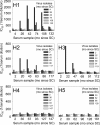Autologous neutralizing humoral immunity and evolution of the viral envelope in the course of subtype B human immunodeficiency virus type 1 infection
- PMID: 18524815
- PMCID: PMC2519599
- DOI: 10.1128/JVI.00757-08
Autologous neutralizing humoral immunity and evolution of the viral envelope in the course of subtype B human immunodeficiency virus type 1 infection
Abstract
Most human immunodeficiency virus type 1 (HIV-1)-infected individuals develop an HIV-specific neutralizing antibody (NAb) response that selects for escape variants of the virus. Here, we studied autologous NAb responses in five typical CCR5-using progressors in relation to viral NAb escape and molecular changes in the viral envelope (Env) in the period from seroconversion until after AIDS diagnosis. In sera from three patients, high-titer neutralizing activity was observed against the earliest autologous virus variants, followed by declining humoral immune responses against subsequent viral escape variants. Autologous neutralizing activity was undetectable in sera from two patients. Patients with high-titer neutralizing activity in serum showed the strongest positive selection pressure on Env early in infection. In the initial phase of infection, gp160 length and the number of potential N-linked glycosylation sites (PNGS) increased in viruses from all patients. Over the course of infection, positive selection pressure declined as the NAb response subsided, coinciding with reversions of changes in gp160 length and the number of PNGS. A number of identical amino acid changes were observed over the course of infection in the viral quasispecies of different patients. Our results indicate that although neutralizing autologous humoral immunity may have a limited effect on the disease course, it is an important selection pressure in virus evolution early in infection, while declining HIV-specific humoral immunity in later stages may coincide with reversion of NAb-driven changes in Env.
Figures







References
-
- Albert, J., B. Abrahamsson, K. Nagy, E. Aurelius, H. Gaines, G. Nystrom, and E. M. Fenyö. 1990. Rapid development of isolate-specific neutralizing antibodies after primary HIV-1 infection and consequent emergence of virus variants which resist neutralization by autologous sera. AIDS 4107-112. - PubMed
-
- Baum, L. L., K. J. Cassutt, K. Knigge, R. Khattri, J. Margolick, C. Rinaldo, C. A. Kleeberger, P. Nishanian, D. R. Henrard, and J. Phair. 1996. HIV-1 gp120-specific antibody-dependent cell-mediated cytotoxicity correlates with rate of disease progression. J. Immunol. 1572168-2173. - PubMed
-
- Beaumont, T., E. Quakkelaar, A. van Nuenen, R. Pantophlet, and H. Schuitemaker. 2004. Increased sensitivity to CD4 binding site-directed neutralization following in vitro propagation on primary lymphocytes of a neutralization-resistant human immunodeficiency virus IIIB strain isolated from an accidentally infected laboratory worker. J. Virol. 785651-5657. - PMC - PubMed
Publication types
MeSH terms
Substances
LinkOut - more resources
Full Text Sources
Other Literature Sources
Molecular Biology Databases

